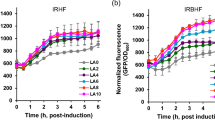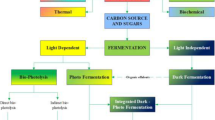Abstract
Cellobiose is a major intermediate from cellulase hydrolysis of pretreated plant biomass. Engineering biocatalysts for direct use of cellobiose could eliminate the need for exogenous β-glucosidase. Additionally, rapid removal of cellobiose in a simultaneous saccharification and fermentation facilitates enzymatic hydrolysis as cellobiose is a potent inhibitor for cellulases. We report here improved cellobiose utilization by engineering Escherichia coli to assimilate the disaccharide both hydrolytically and phosphorolytically (shorter fermentation time). Additionally, we demonstrate that engineering intracellular cellobiose utilization circumvents catabolite repression allowing simultaneous fermentation of xylose and cellobiose. Using meso-2,3-butanediol as model product, we further demonstrate that the accelerated carbon metabolism led to improved product formation (higher titers and shorter fermentation times), illustrating the utility of the engineered biocatalysts in biorefinery applications.



Similar content being viewed by others
References
Ait N, Creuzet N, Cattaneo J (1979) Characterization and purification of thermostable beta-glucosidase from Clostridium thermocellum. Biochem Biophys Res Commun 90:537–546
Alvira P, Tomás-Pejó E, Ballesteros M, Negro MJ (2010) Pretreatment technologies for an efficient bioethanol production process based on enzymatic hydrolysis: a review. Bioresour Technol 101:4851–4861
Barr BK, Hsieh YL, Ganem B, Wilson DB (1996) Identification of two functionally different classes of exocellulases. Biochemistry 35:586–592
Bezerra RM, Dias AA (2005) Enzymatic kinetic of cellulose hydrolysis. Appl Biochem Biotechnol 126:49–59
Carere CR, Sparling R, Cicek N, Levin DB (2008) Third generation biofuels via direct cellulose fermentation. Int J Mol Sci 9:1342–1360
Coughlan M, Ljungdahl L (1988) Comparative biochemistry of fungal and bacterial cellulolytic enzyme systems, FEMS Symposium. Plenum Press, New York
Fendri I, Tardif C, Fierobe HP, Lignon S, Valette O, Pages S, Perret S (2009) The cellulosomes from Clostridium cellulolyticum: identification of new components and synergies between complexes. FEBS J 276:3076–3086
Gruno M, Väljamäe P, Pettersson G, Johansson G (2004) Inhibition of the Trichoderma reesei cellulases by cellobiose is strongly dependent on the nature of the substrate. Biotechnol Bioeng 86:503–511
Kim Y, Ingram L, Shanmugam K (2007) Construction of an Escherichia coli K-12 mutant for homoethanologenic fermentation of glucose or xylose without foreign genes. Appl Environ Microbiol 73:1766–1771
Kumar P, Barrett DM, Delwiche MJ, Stroeve P (2009) Methods for pretreatment of lignocellulosic biomass for efficient hydrolysis and biofuel production. Ind Eng Chem Res 48:3713–3729
Lavarack BP, Griffin GJ, Rodman D (2002) The acid hydrolysis of sugarcane bagasse hemicellulose to produce xylose, arabinose, glucose and other products. Biomass Bioenerg 23:367–380
Lawford H, Rousseau J (1993) Effects of pH and acetic acid on glucose and xylose metabolism by a genetically engineered ethanologenic Escherichia coli. Appl Biochem Biotechnol 39–40:301–322
Moxley G, Zhu Z, Zhang YP (2008) Efficient sugar release by the cellulose solvent-based lignocellulose fractionation technology and enzymatic cellulose hydrolysis. J Agric Food Chem 56:7885–7890
Qin J, Xiao Z, Ma C, Xie N, Liu P, Xu P (2006) Production of 2, 3-butanediol by Klebsiella pneumoniae using glucose and ammonium phosphate. Chin J Chem Eng 14:132–136
Rutter C, Mao Z, Chen R (2013) Periplasmic expression of a Saccharophagus cellodextrinase enables E. coli to ferment cellodextrin. Appl Microbiol Biotechnol 97(18):8129–8138
Saha BC, Bothast RJ (1996) Production, purification, and characterization of a highly glucose-tolerant novel beta-glucosidase from Candida peltata. Appl Environ Microbiol 62:3165–3170
Sekar R, Shin HD, Chen R (2012) Engineering Escherichia coli cells for cellobiose assimilation through a phosphorolytic mechanism. Appl Environ Microbiol 78:1611–1614
Shin HD, Yoon SH, Wu J, Rutter C, Kim SW, Chen RR (2012) High-yield production of meso-2,3-butanediol from cellodextrin by engineered E. coli biocatalysts. Bioresour Technol 118:367–373
Tokuhiro K, Ishida N, Kondo A, Takahashi H (2008) Lactic fermentation of cellobiose by a yeast strain displaying β-glucosidase on the cell surface. Appl Microbiol Biotechnol 79:481–488
Zhao Y, Wu B, Yan B, Gao P (2004) Mechanism of cellobiose inhibition in cellulose hydrolysis by cellobiohydrolase. Sci China C 47:18–24
Acknowledgments
This research is supported by NSF via a subcontract from University of California at Riverside, and a grant from Korea Institute of Advanced Technology (KiaT).
Author information
Authors and Affiliations
Corresponding author
Electronic supplementary material
Below is the link to the electronic supplementary material.
Rights and permissions
About this article
Cite this article
Rutter, C., Chen, R. Improved cellobiose utilization in E. coli by including both hydrolysis and phosphorolysis mechanisms. Biotechnol Lett 36, 301–307 (2014). https://doi.org/10.1007/s10529-013-1355-7
Received:
Accepted:
Published:
Issue Date:
DOI: https://doi.org/10.1007/s10529-013-1355-7




